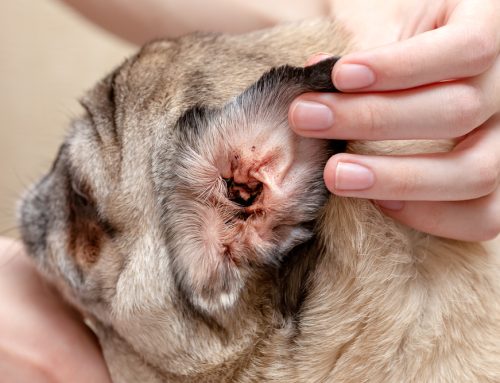Itchy, irritated, and inflamed skin is a common problem that is extremely uncomfortable for your pet, and their constant scratching, biting, and licking is likely extremely frustrating for you and your family. Our Countryside Veterinary Hospital team explains three reasons that may be responsible for your pet’s itchiness and ways to address the problem.
Flea allergy dermatitis may cause your pet’s itchy skin
Fleas are the most common external parasites found on pets worldwide, and flea allergy dermatitis (FAD) is the most frequently diagnosed skin disease in U.S. cats and dogs. When a flea takes a blood meal from a pet, they inject saliva that contains numerous inflammatory components, which provokes immunological responses, including immediate and delayed hypersensitivity reactions in susceptible pets. And, only one flea bite can initiate the reaction. Other pertinent FAD information includes:
- Signs — Affected pets are exceptionally itchy, and will scratch, bite, lick, and rub incessantly. They also may have skin lesions, including red bumps, crusting, excoriations, hair loss, and hot spots. In FAD, these lesions are typically distributed over the lower back, tail base, inner thighs, and abdomen. You may expect to see fleas in your pet’s coat, but many pets groom the fleas away. However, you will likely see flea dirt (i.e., excrement) in your pet’s coat or in their bedding.
- Diagnosis — Finding a flea or flea dirt on your pet suggests that FAD is causing their itchy skin. Our team will use a fine-toothed comb, called a flea comb, to assess your pet’s coat and may also recommend flea treatment to try to resolve your pet’s problem.
- Treatment — FAD treatment involves:
- Flea control — All fleas must be removed from your pet and their environment. Every household pet should receive appropriate flea control products, your pet’s bedding should be washed or discarded, your floors and upholstery vacuumed, and your home treated with insecticide. You will likely have to treat your home multiple times to eradicate the fleas at every life stage.
- Bathing — Bathing your pet in pet-safe shampoo can help remove the fleas and soothe their skin.
- Antimicrobials — Antibiotics or antifungals may be necessary to address secondary bacterial and fungal infections.
- Symptomatic therapy — Your pet may need medications to control their itchiness and inflammation until their lesions clear.
- Prevention — Keep your pet on year-round flea prevention medication to prevent FAD.
Atopic dermatitis may cause your pet’s itchy skin
Atopic dermatitis, which is caused by environmental allergens such as pollens, molds, grasses, and dust mites, is the second most common dermatological disease in pets. Affected pets have a defective skin barrier that allows allergens to penetrate, stimulating inflammatory cells and itch mediators to infiltrate the skin. Certain dog breeds, including the Shar-pei, golden retriever, Labrador retriever, boxer, and pug, are at increased risk for atopic dermatitis, but no breed predisposition occurs in cats. Other pertinent information about atopic dermatitis includes:
- Signs — Affected pets are extremely itchy, and commonly exhibit areas of hair loss around the eyes and mouth, the abdomen, and under the tail, armpits, abdomen, and feet. Most affected pets begin exhibiting signs between 1 and 3 years of age, live mostly indoors, and suffer from recurrent skin and ear infections. Depending on the cause of the pet’s reaction, the condition may be seasonal. Pets affected by atopic dermatitis typically respond well to steroid treatment.
- Diagnosis — If our team suspects atopic dermatitis, we may recommend allergy testing to determine what allergens are causing your pet’s reaction. These tests involve either a blood test or intradermal skin testing.
- Treatment — Atopic dermatitis cannot be cured and only managed, typically using a multi-modal approach:
- Flea control — Fleas can exacerbate atopic dermatitis, so your pet should receive year-round flea control.
- Bathing — Bathing can help remove allergens from your pet’s skin and coat.
- Steroids — Steroids are often used in acute flares to control inflammation and itch, but can lead to serious side effects, and should not be used long-term or at high doses.
- Anti-itch medications — Our team will determine which of several anti-itch medications will work best for your pet.
- Omega-3 fatty acids — Omega-3 fatty acid supplements can improve skin health and decrease inflammation.
- Hyposensitization — Our team can use the information from your pet’s allergy testing to produce allergy shots that we inject with gradually increasing allergen amounts to hyposensitize your pet.
- Prevention — Atopic dermatitis cannot be prevented, but you can reduce your pet’s risk of a flare by bathing them weekly, washing their bedding frequently, vacuuming and dusting regularly, minimizing houseplants, and keeping them inside when your lawn is mowed.
Food allergies may cause your pet’s itchy skin

Pets can be allergic to ingredients in their food, most commonly a protein or complex carbohydrate, and dairy, beef, chicken, eggs, soy, or wheat gluten are common culprits. Food allergies take time to develop, and most pets have been eating the problematic food for years before signs occur. Other pertinent information about food allergies includes:
- Signs — Food allergies make pets extremely itchy. Dogs typically exhibit facial itching, foot or limb chewing, an itchy anal area, and recurrent ear infections. Cats usually have itching, hair loss, and skin lesions around their face and neck. Some pets may also suffer with gastrointestinal (GI) signs such as vomiting, diarrhea, and gas. Pets affected by a food allergy typically do not respond well to steroid treatment.
- Diagnosis — To determine the causative ingredient, your pet must undergo a hypoallergenic diet trial:
- Choose a hypoallergenic diet — You can use a novel protein diet that your pet has never eaten or a hydrolyzed diet in which the protein is broken down into molecules too small for the body to recognize.
- Be consistent — Your pet must eat only the hypoallergenic diet, meaning they can’t have flavored chewable medications, treats, or vitamins that contain other protein sources. They should eat this diet for at least eight weeks to determine if their food is causing their itching.
- Reintroduce ingredients — If your pet responds well, once their skin is healthy, you can reintroduce ingredients from their previous food one at a time to determine the ingredient that caused the reaction.
- Treatment — Anti-itch medications are typically used to control inflammation and itchiness until the causative ingredient is determined.
- Prevention — Once you determine the causative ingredient, ensure your pet never eats that ingredient to prevent a reaction.
If your pet is itchy, contact our Countryside Veterinary Hospital team, so we can determine what is causing the problem and devise an effective treatment strategy that will give them relief.








Leave A Comment